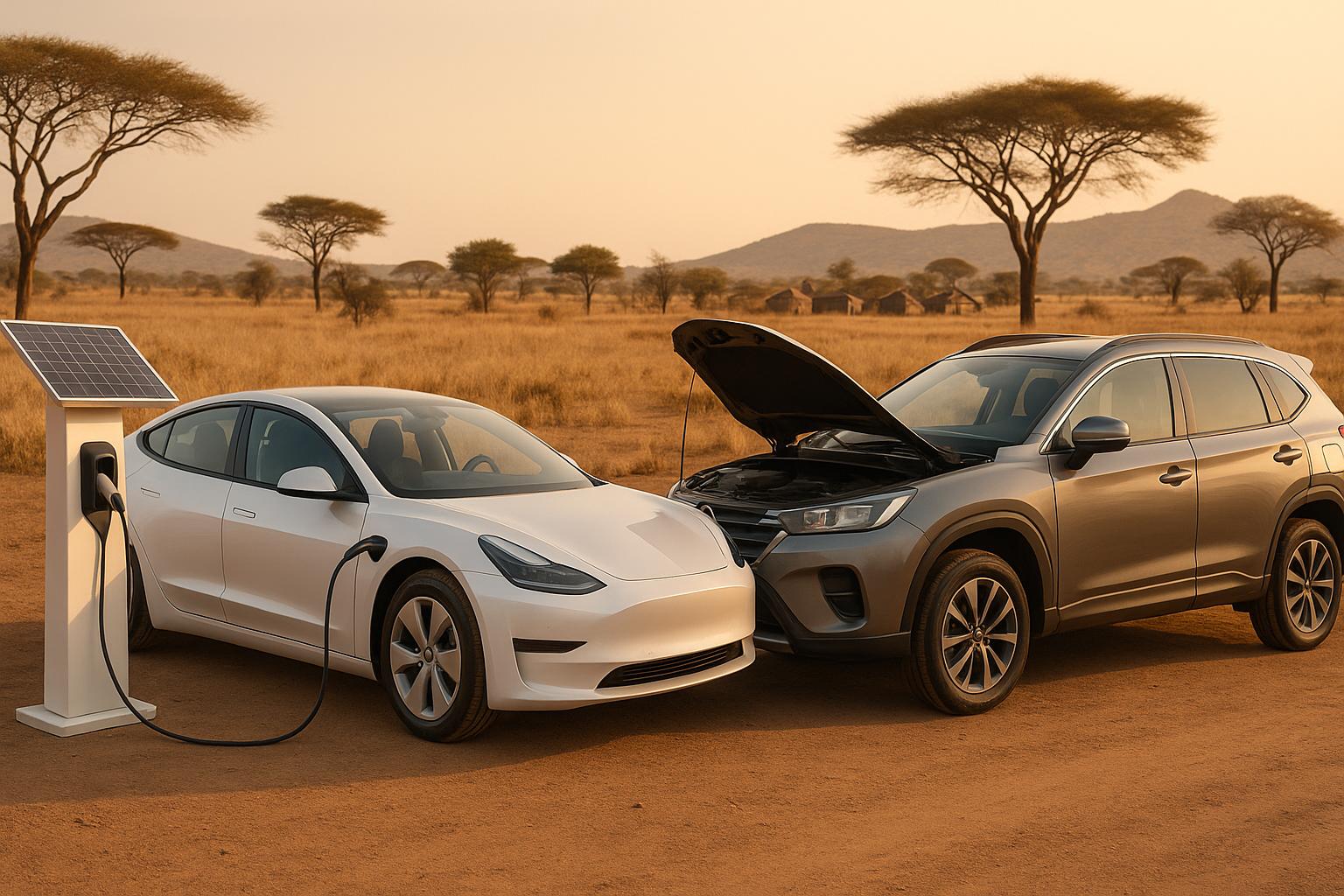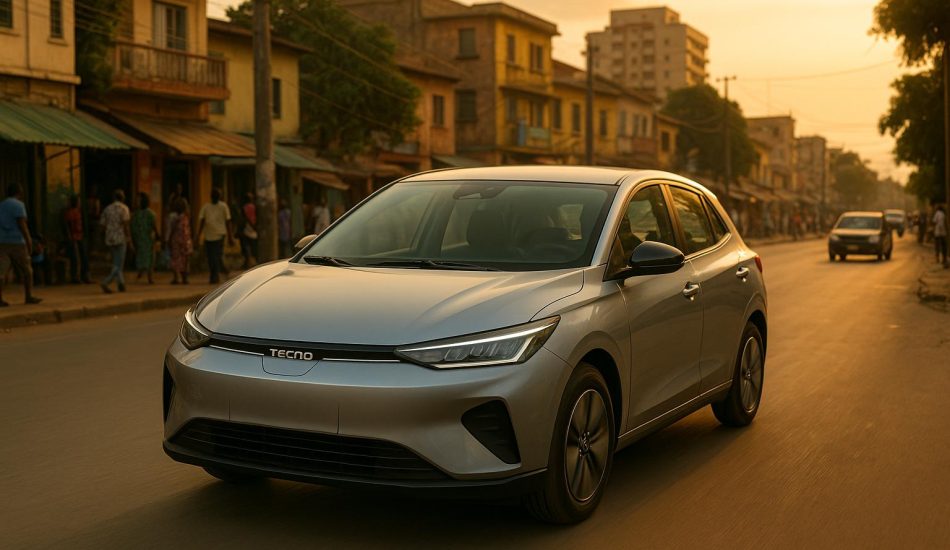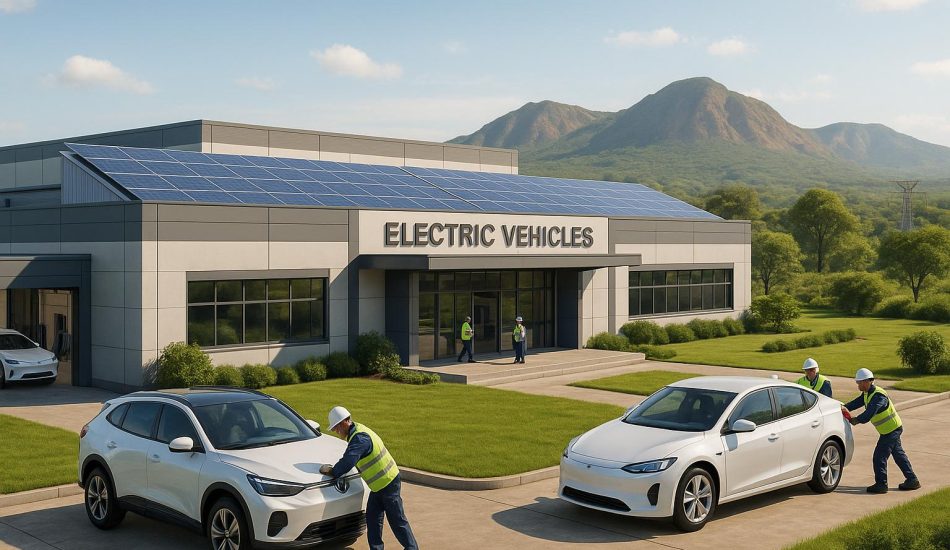
Choosing between electric vehicles (EVs) and hybrid cars in Africa comes down to your power access, driving needs, and budget. Here’s a quick guide to help you decide:
- Electric Vehicles (EVs): Best for urban areas with reliable electricity and growing charging networks. They have zero emissions but higher upfront costs and depend on consistent power.
- Hybrid Cars: Ideal for regions with unreliable electricity. They combine gas and electric power, offering flexibility, lower initial costs, and compatibility with existing infrastructure.
Quick Comparison
| Factor | Electric Vehicles (EVs) | Hybrid Vehicles |
|---|---|---|
| Power Source | Fully electric | Combines gas and electricity |
| Infrastructure Needs | Requires charging stations | Works with fuel stations |
| Initial Cost | Higher | Lower |
| Environmental Impact | Zero emissions | Reduced emissions |
| Suitability | Urban areas with stable power | Varied conditions |
Africa’s EV market is growing, but challenges like unreliable power grids and limited charging stations make hybrids a practical choice for many. Consider your daily routes, access to electricity, and long-term goals when deciding.
Are electric vehicles actually selling in South Africa? EV and hybrid sales stats 2024
Power Supply and Access
Africa’s power infrastructure presents unique challenges for electric and hybrid vehicles. To better understand these dynamics, let’s dive into how EV charging networks stack up against traditional gas stations.
EV Charging vs. Gas Stations
The availability of charging stations across Africa varies significantly. South Africa boasts the most extensive EV charging network on the continent and ranked fifth globally in 2020 for the ratio of public charging stations to electric vehicles. Yet, with only around 1,000 electric cars on its roads, much of this infrastructure remains underused.
Egypt is making strides to improve its charging accessibility. In January 2022, MB for Engineering teamed up with Wataniya Petroleum to open the nation’s largest charging station. Key features include:
| Feature | Specification |
|---|---|
| Simultaneous Charging | 14 vehicles |
| Power Capacity | 330+ kilowatt-hours |
| Coverage | Top 5 governorates |
| Implementation Timeline | First half of 2022 |
While gas stations are plentiful and continue to support hybrid vehicles, electric mobility is gaining traction through innovative solutions. Rwanda, for example, has focused on electric motorcycles. Companies like Ampersand are leading the way, with their fleet covering over 1.3 million kilometers since May 2019. This shift has cut carbon emissions by at least 75% compared to traditional gasoline-powered motorcycles. These efforts highlight the growing focus on sustainable transport and set the stage for discussing the impact of grid reliability and solar power on vehicle performance in Africa.
Power Grid Status and Solar Options
The reliability of Africa’s power grid plays a significant role in shaping the performance and adoption of electric vehicles. A survey across 39 African countries revealed that just 44% of respondents experienced consistent electricity from the grid. Despite these challenges, solar charging initiatives are emerging as a game-changer.
"At ROAM, we believe that simplifying the charging experience is essential to electric motorcycle adoption and customer satisfaction. We are confident that this hassle-free charging experience is what will eventually turn the boda-boda industry electric." – Habib Lukaya, Energy & Charging Product Manager, ROAM
Several solar-powered projects are making a noticeable impact:
- Cheetah Plains operates a 330kWp solar plant with 1,205 panels, producing 550MWh annually and offsetting 530 tons of CO2 emissions.
- Campi ya Kanzi runs a 320 kW photovoltaic system that can charge up to eight vehicles at once.
- ROAM has introduced Africa’s first solar-powered charging hubs in Nairobi, with plans to expand to 15 locations by the end of 2023.
Hybrid vehicles, with their ability to switch between fuel and electricity, provide a practical solution in areas where grid reliability is low. This dual capability is particularly important in regions prone to power outages. However, exceptions exist – Mauritius and Seychelles, for instance, achieved nearly universal access to reliable electricity between 2021 and 2023.
In urban centers with growing charging networks, fully electric vehicles may thrive. However, hybrids remain a more versatile option for areas where electrical infrastructure is still developing.
Price Breakdown
Initial Costs and Payment Plans
Electric vehicles (EVs) come in a variety of price points, catering to different budgets. For instance, entry-level EVs like the LINGBOX UNI start as low as $4,800, while high-end models such as the VOYAH DREAMER EV can cost up to $97,000. Many EV manufacturers also provide flexible financing plans, making it easier for buyers to manage payments.
Here’s a quick look at the pricing landscape of popular EV categories:
| Vehicle Category | Price Range | Example Models |
|---|---|---|
| Entry Level | $4,800 – $10,000 | LINGBOX UNI ($4,800), GEELY PANDA MINI BASE ($5,880) |
| Mid-Range | $25,000 – $45,000 | BYD models, Leapmotor models |
| Premium | $75,000 – $97,000 | ZEEKR 009 ($85,000), VOYAH DREAMER EV ($97,000) |
Once you’ve considered the upfront costs, it’s important to dive into operating expenses to get a clear picture of the total cost of ownership.
sbb-itb-99e19e3
Green Impact
Emissions and Air Quality Effects
Transportation is responsible for 24% of global CO2 emissions. In urban areas, electric vehicles (EVs) present an immediate opportunity to improve air quality. For instance, particulate matter and ozone from transportation were linked to nearly 4,500 deaths in Sub-Saharan Africa in 2015. EVs also boast an impressive efficiency rate of 90%, compared to the 12-40% efficiency range of combustion engines.
The potential for emissions reduction varies significantly by region:
| Country | EV Value Proposition | Implementation Barriers | Current Impact |
|---|---|---|---|
| Zimbabwe | High | Low | Immediate emissions reduction |
| Kenya | High | High | Limited by infrastructure |
| Mauritius | Low | Low | Moderate impact potential |
| Tunisia | Low | High | Minimal current benefit |
"The contribution of EVs to decarbonization is more complicated than just swapping them in for existing ICE vehicles, because their ultimate carbon footprint is determined by the source of their electricity and how they are manufactured." – Jay Taneja, June Lukuyu, Rebekah Shirley
Countries like Ethiopia, Uganda, the Democratic Republic of the Congo, and Namibia hold the highest potential for emissions reduction through EV adoption. This is largely due to their cleaner electricity generation methods. Next, let’s explore how EVs and combustion vehicles address challenges at the end of their lifespans, particularly regarding battery disposal.
Battery Disposal Solutions
While EVs reduce operational emissions, their environmental impact also hinges on how batteries are disposed of. EV batteries typically last 8–15 years, with disposal costs ranging from $200 to $500.
Key environmental challenges include:
- Toxic Materials: EV batteries contain heavy metals and chemicals that require careful handling.
- Disposal Infrastructure: Many regions in Africa lack the facilities needed for proper battery processing.
- Environmental Risk: Improper disposal can contaminate soil and water, posing serious ecological hazards.
"By carefully considering the end-of-life management of electric car batteries, we can make sure that our efforts to reduce emissions and protect the environment are not undone by the negative impacts of battery disposal." – Electric Car Wiki
To address these concerns, several sustainable solutions are being developed:
| Solution | Environmental Benefit | Cost Impact |
|---|---|---|
| Battery Recycling | Recovers valuable materials (like lithium and cobalt) | Higher upfront cost, long-term savings |
| Energy Storage Repurposing | Extends battery life cycle | Reduces disposal needs |
| Manufacturer Take-back Programs | Ensures proper disposal | Included in vehicle cost |
Although recycling comes with higher initial costs, it proves more economical over time by recovering valuable materials and preventing environmental damage. The success of these solutions depends on building the right infrastructure and implementing efficient collection systems across African countries.
Buying Guide
Power Access and Daily Routes
In many regions, unreliable power grids can make charging electric vehicles (EVs) a challenge. Understanding your area’s power situation and typical driving patterns is crucial when deciding between an EV and a hybrid.
- Power Supply Assessment In sub-Saharan Africa, the average annual System Average Interruption Duration Index (SAIDI) is 39.30 hours, compared to just 0.87 hours in OECD countries. This stark difference indicates that hybrid vehicles may be more practical in areas with frequent power outages.
- Charging Infrastructure The cost of installing Level 2 charging equipment ranges from $200 to $1,000, while Level 3 (DC fast charging) setups can cost tens of thousands of dollars. To determine whether an EV fits your lifestyle, consider your daily routes and the availability of charging stations:
Route Type EV Suitability Hybrid Suitability Urban (< 30 miles) High High Suburban (30–60 miles) Moderate High Rural (> 60 miles) Low High Areas with unreliable power Low High
By examining your power access and driving habits, you can better gauge whether an EV or a hybrid is the right fit for your needs.
Key Decision Factors
Once you’ve assessed your power and route conditions, it’s time to weigh the broader costs and practicalities of ownership. Here’s a quick comparison:
| Factor | Electric Vehicle | Hybrid Vehicle |
|---|---|---|
| Initial Cost | Used EVs: $6,000–$10,000 | Similar to traditional gas-powered cars |
| Infrastructure Needs | Requires home charging setup | Relies on standard fuel stations |
| Maintenance | Needs specialized service | Easy access to service providers |
Your decision should reflect not only your current circumstances but also the potential for future improvements in charging infrastructure and the environmental benefits of EVs.
Long-term Value
Beyond the immediate considerations, think about the long-term outlook for EV adoption. In sub-Saharan Africa, EV numbers are expected to more than double by 2030. Here are some key areas to watch:
- Infrastructure Development
- Expansion of charging networks
- Improvements in grid reliability
- Availability of solar-powered charging options
- Technology Advancement
- Better battery technology
- Longer driving ranges
- Reduced maintenance costs
- Market Evolution
- Growth of service and repair networks
- Greater availability of replacement parts
- Improvements in resale value
The environmental advantages of EVs are a strong selling point. For example, European EVs produce 65–85% fewer lifecycle emissions compared to traditional vehicles. Electric buses powered by solar energy emit up to 329 times less pollution than their conventional counterparts.
However, regional factors play a big role. Ghana, for instance, has committed to reducing emissions by 64 MtCO₂, but EV adoption remains low. This could mean future incentives for early adopters, making it worthwhile to keep an eye on policy developments in your area.
Conclusion
Choosing between electric and hybrid vehicles in Africa depends heavily on your driving needs and the realities of a rapidly changing market. As the continent steadily develops its electric vehicle (EV) ecosystem, it’s clear there’s a growing commitment to cleaner, more sustainable transportation.
For city drivers in regions with dependable electricity – like Kenya, where renewable energy powers 93% of the grid – EVs can be a smart option. While their upfront costs may seem steep, the lower maintenance requirements and environmental benefits can make them a worthwhile choice where infrastructure supports their use.
That said, hybrid vehicles often emerge as the more practical option for many African drivers today. A closer look at key factors highlights why:
| Factor | Current Status | Impact on Choice |
|---|---|---|
| Grid Reliability | Limited power consistency | Hybrids are more dependable |
| Infrastructure | Early-stage charging networks | Hybrids offer greater range |
| Operating Costs | Lower EV maintenance costs | EVs have long-term savings |
"South Africa is seeing an uptick in new-energy vehicles (NEV) like hybrids or electric vehicles – incentivized by the idea of saying goodbye to petrol stations for good."
– Keletso Mpisane, head of Blink by MiWay
This trend is evident in South Africa, where NEV sales saw a 65% increase in 2023 compared to the previous year. It’s a clear sign that confidence in sustainable transportation is growing, especially in areas where charging infrastructure is improving. For now, hybrids often act as a practical stepping stone toward full EV adoption as the necessary networks expand.
When deciding, consider your access to reliable power, your daily driving patterns, and the state of local infrastructure. The landscape of sustainable mobility in Africa is evolving quickly, and staying informed will help you make the best choice for your needs.
FAQs
What are the environmental differences between electric and hybrid vehicles in Africa?
Electric vehicles (EVs) are known for producing fewer greenhouse gas (GHG) emissions over their lifetime compared to hybrid vehicles (HEVs) or traditional gas-powered cars. However, their environmental impact in Africa heavily depends on the source of electricity used for charging. When EVs are powered by renewable energy, their carbon footprint drops dramatically. For instance, an electric bus charged with solar energy can emit up to 329 times less than a conventional internal combustion engine (ICE) bus.
Hybrid vehicles, while still reliant on fossil fuels, offer a 20% reduction in GHG emissions compared to standard gasoline cars. Their improved fuel efficiency makes them a more environmentally friendly option in regions where access to renewable energy or EV charging infrastructure is limited. In essence, EVs deliver the best environmental outcomes when paired with clean energy, while hybrids act as a practical alternative in areas where renewable energy remains scarce.
What are the long-term advantages of choosing an electric vehicle over a hybrid in Africa?
Electric vehicles (EVs) come with several long-term perks compared to hybrid cars, particularly when considering the African landscape. One standout benefit is their lower operating costs. Because EVs run entirely on electricity, they eliminate the need for gasoline or diesel – fuels that can be pricey and prone to unpredictable price shifts. Plus, with fewer moving parts, EVs generally require less maintenance, which translates to savings over time.
On the environmental side, EVs shine by producing zero tailpipe emissions, making them a cleaner alternative for areas aiming to tackle air pollution and cut down on carbon emissions. As renewable energy sources, like solar power, become more accessible across parts of Africa, EVs offer an even greater opportunity to reduce environmental impact.
While hybrids serve as a practical stepping stone, EVs have the long-term potential to align seamlessly with sustainable energy advancements and offer lower ownership costs. This makes them an appealing option for many African drivers looking ahead.
How do solar-powered charging options impact the practicality of electric vehicles in Africa?
Solar-powered charging stations could make electric vehicles (EVs) much more practical across Africa, particularly in areas where reliable electricity is hard to come by. With many regions enjoying plentiful sunlight throughout the year, solar energy offers a renewable and cost-efficient way to keep EVs charged. By tapping into this abundant resource, EV drivers can cut back on their dependence on the traditional power grid and save on charging expenses.
That said, the success of solar-powered charging hinges on having the right infrastructure in place – like solar panels and charging stations – as well as managing the initial costs of installation. While the potential is clear, making solar charging widely accessible will take a combined effort from governments, businesses, and local communities to encourage adoption and ensure it remains a viable solution over the long term.




